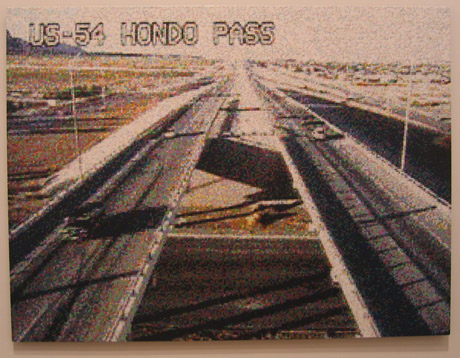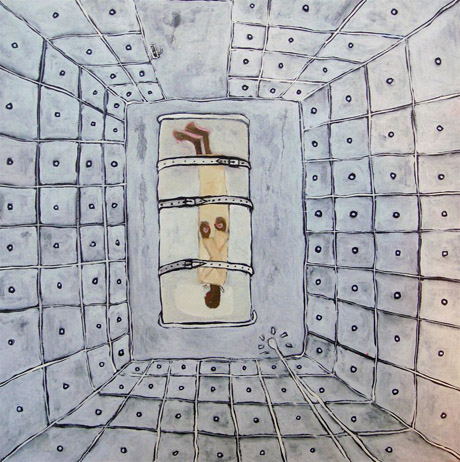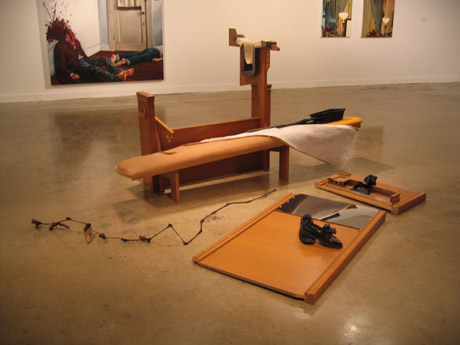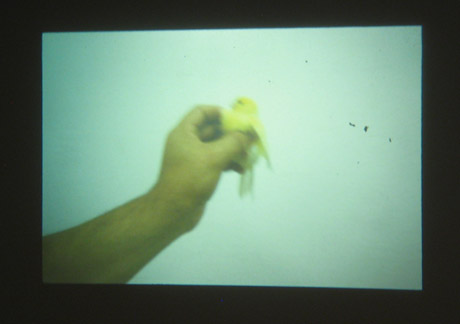Over at UH’s Blaffer Gallery, it was summer vacation. A half-dozen student gallery attendants were chatting companionably at the front desk, and had to spread out to their stations, dutifully eyeing me as I, the sole visitor on this weekday afternoon, dutifully looked over this year’s Houston Area Show for an entire hour.

Having just finished rehabbing my house and studio (hence the blog drought), I was drawn to the oddball carpentry of Lynn McCabe’s Building Walls Together. It’s an ungainly construction: three sheets of drywall form a crude temporary wall with a forest of crooked, unnecessary studs and braces behind the scenes. It’s a collaboration: the four studs actually necessary to mount the drywall were suspiciously straight. A cloud of letters and photographs stapled to an adjacent gallery wall explained the project: McCabe built the wall with a dozen children (whose parents signed releases and permission slips) in an experiment in crowdsourcing, vocational education, or child labor, depending on how you look at it ("children" were listed as one of the materials on the wall tag).

This photo gave me chills, but apparently, there were no injuries. The piece is fun to look at, and was probably fun to build, but provides few surprises. My enjoyment of the piece was somewhat dampened by its earnestness: the dutiful contextualization of this enjoyable educational activity as art seems an afterthought.

There’s nothing funny about William Betts’ technically polished digital pointillism. It is the perfect vehicle for his imagery: unremarkable, empty landscape photos taken by automated surveillance cameras.

Gabriela Trzebinski’s naive-style political paintings completely backfire. Like a newspaper comic where prisoners chained side-by-side in a dungeon exchange a joke, Trzebinski’s paintings make terrible things ridiculous through caricature, except not on purpose. Terrible torture kitsch.

Revisiting at the photos I took of Jonathan Durham’s sculptural work, There’s a Beggar In Them Woods, I began to assemble a dramatic narrative for the piece, something I wasn’t tempted to do in the gallery. The dismembered church pews, tobacco shreds, ashes, burned basket and rubbery-coated severed toes and fingers began to coalesce into a scenario: a shoeless tramp lying on a church pew for shelter, his head a burned basket, his fingers and feet chopped like a cigar end by a sheet of steel that might be a guillotine. In person, the drama of the piece is masked by the aestheticised, bland, shop-window-style display and overridden by the soundtrack of his nearby video piece echoing over everything else in the gallery.

Where Durham’s piece uses a furniture showroom full of props to conjure a blurry image, Andres Janacua’s slide show, Bird in Hand, is crisp and pointed. A male arm prisons and manipulates a small yellow bird with disturbing, but not explicitly cruel, roughness. The subtitle of the piece, "for a new colonial theory" suggests that the very powerful sense of unease the images create is a metaphor for colonialism. Sure, why not? As a way of making us oppressors feel for the oppressed, it’s hard to beat. I didn’t even think of suggesting that the bird was actually happier with someone taking care of him, or that he’d brought it upon himself. Janacua’s deft sleight of hand in substituting a one victim for another neatly short-circuits conventional apologies based on history, economics, race, or cynicism, making dull politics raw and personal.
There’s a lot more, maybe I’ll get to it later.



